Classification of muffle furnaces
By the type of heating elements, muffle furnaces are divided into:
- electrical;
- gas.
By design, they are divided into:
- for metal melting;
- for firing ceramics;
- for glass melting;
- for metal hardening;
There are also industrial and homemade muffle furnaces.
Industrial muffle furnace with automation
But it is impossible to make gas stoves at home, although gas is cheaper than electricity, since such experiments are prohibited by law. The electric control of the oven provides convenient temperature control.
By their constructive type, muffle furnaces are divided into:
- horizontal (the most simple);
- vertical or pot type;
- bell-type;
- tubular.
Heating can be carried out in air, in a vacuum or in a gas environment. At home, there is only an opportunity to design a furnace with heat treatment of products in an air environment.
If you make a muffle furnace yourself, you can give it the desired shape and volume, and arrange it in a style suitable for the interior.
Main parts of the structure
- Outer part of the furnace, shell (body). As a body for a future muffle furnace, it is convenient to use a disused gas stove, more precisely an oven from it or an electric stove. For their use, all plastic parts are dismantled. In the case when it is not possible to use such housing options, it is welded from sheet metal (at least two millimeters thick).
- Heat insulating layer. This part of the design is extremely important. The efficiency of the furnace and the heat loss that it will incur depends on its quality. The inner layer of thermal insulation is a refractory (fireclay) brick that can withstand temperatures up to one thousand degrees.
- The outer layer, which reduces heat loss to the surrounding space, is made of perlite or basalt wool. It is unsafe to use asbestos; when it is heated, carcinogenic substances are released into the atmosphere.
- Elements that directly heat the workspace. The heating elements inside the muffle furnace are spirals twisted from nichrome or fechralic wire. Thickness 1 mm. Nichrome (nickel-chromium) wire is very ductile and resistant to corrosion.
- Fechral (aluminum, chromium, iron) wire is somewhat cheaper due to the absence of aluminum in the composition and also has the necessary properties for its use in a muffle furnace.
List of materials and tools for the assembly of the structure
- grinder (machine for grinding and cutting materials) with cutting wheels for metal;
- welding machine;
- sheet steel> 2mm thick;
- metal corners;
- fireclay fire-resistant brick;
- refractory mixture;
- heat-resistant silicone;
- basalt thermal insulator (wool, density 200 kg / m3) or perlite;
- goggles and respirator;
- nichrome (fechral) wire with a cross section of 1 mm;
- nippers or scissors for metal.
Manufacturing the device
In this case, we will tell you how to make a vertical muffle furnace for firing ceramics with your own hands.
To do this, you need the following tools:
- angle grinder (grinder) and 1-2 circles;
- electric arc welding and electrodes;
- locksmith tools, including wire cutters;
- 2mm nichrome wire.
and materials:
- 2.5 mm steel sheet or used oven body;
- corner;
- fittings;
- basalt wool;
- refractory fireclay bricks;
- refractory mortar;
- silicone sealant.
DIY Tips
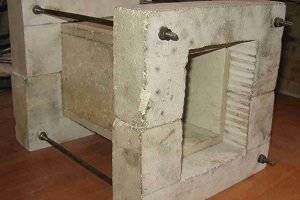
- Separating fireclay bricks and drilling holes for installing a heating element.
When creating from fireclay bricks, any pottery hardening requires the use of a heating element.And if there is a need to place an appropriate solution, then it will be necessary to make cuts and technical cavities in the ceramic material. It is best to first mark the entire location of the element and only then resort to making cuts. All this can be done at home using simple power tools.
It is worth starting with sawing the seams using a cutting machine with a special diamond wheel. And then it will be necessary to remove the resulting sections of ceramics. And here it is best to use a perforator drill. Since this will avoid cracking and damage to the material and each of the elements. You should not use a hammer and chisel, because upon impact, cracks may form, which will subsequently lead to the unusability of each of the elements.
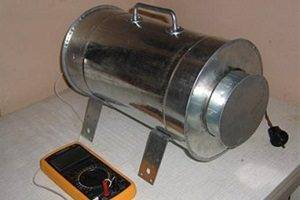
- Choice of small or large muffle furnace.
The homemade stoves selected and created must be received with an understanding of the technical processes in which they will be involved. And then a logical question arises, to create a more voluminous furnace or to implement a more miniature solution. In the case of jewelry melting, a minimum amount of interior space will suffice. This will allow for more practical use of the products and will not require additional space.
But in the case of blacksmithing, it will be necessary to create more weighty design solutions that will allow melting and hardening of metal.
Watch a video in which the user demonstrates in detail the device of a self-made muffle furnace:
Do-it-yourself muffle furnace: manufacturing instructions
Stage one. From the inside, the cylinder is laid out with basalt wool.

High temperature mats
Fastening basalt wool to the body with ceramic buttons
Stage two. Thermal insulation is being built, for which, as mentioned earlier, only fireclay bricks need to be taken. The procedure is as follows: seven bricks must be joined in the body to form a pipe. In the future, it will serve as a working chamber.

Refractory marking of a muffle furnace
The bricks are laid out in a row, while marks are made on each of them, according to which they will be cut. Further, the trimming takes place, after which the bricks must be of such a shape that they can be connected into one hollow pipe. To simplify the procedure, the bricks can be numbered. At the end of cutting, the pipe is assembled, pulled together with a wire, and the symmetry of the shape is checked. Adjustments are made if necessary.

DIY muffle furnace
Stage three. Nichrome wire is twisted into a ø6 mm spiral by winding it onto a base (used electrode, pencil, etc.). Then the brick is removed from the body and placed back in a row.
We lay the heating coil
Stage four. A spiral is applied to the bricks and future grooves are marked. The correctness of the lines is measured by the building level. As a result, the laid spiral must lead from the bottom to the top of the pipe. Contact of the turns is not allowed, since this can cause a short circuit.
Stage five. To output the ends of the spiral and connect them to the machine with a stabilizer, three strips cut from ceramic tiles with polypropylene channels for the wire are inserted between a pair of bricks. These channels will greatly facilitate future renovations.
Stage six. The finished structure is placed in a steel case. In this case, one brick is placed on the bottom of the case, previously covered with refractory glue. For the output of the ceramic channels, holes are made in the housing in the appropriate places.
The finished structure is placed in a steel case
Stage seven. For the manufacture of the cover, the same sheet steel is used.A circle is cut to the size of the structure, for a more reliable fixation, fireclay brick (1 pc.) Is attached to it on top. Then the handles, canopy and metal latch are welded. The edges of the lid in contact with the oven walls are covered with a layer of fire-resistant silicone. Silicone is applied only to a previously degreased surface.

Oven cover

Oven cover
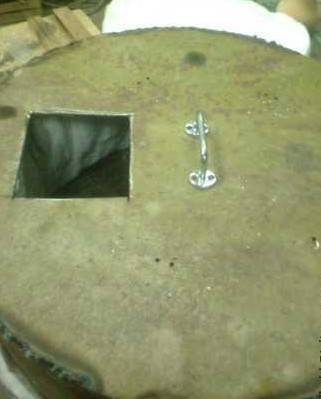
Oven cover
Stage seven. Trial run. For complete drying of the structure, it is installed in a warm, well-ventilated place. It is forbidden to use any heating devices, as this can lead to cracking of the masonry. After drying, the spirals are connected to an automatic machine with a stabilizer, the heating power and operating temperature are adjusted.
The lid must be tightly closed when operating the oven.
Applications

The scheme used should be able to accommodate the required amount of material for processing.
It is worth dividing all ovens into material handling applications:
- hardening of metal and Kremlin products;
- firing and bringing to a certain structure of the material, imparting strength;
- tempering, giving the material plasticity for making the corresponding products;
- blacksmithing, for splitting metal for subsequent processing and creating more acceptable sizes and blanks;
- laboratory research, to study the effect of heat treatment, on metals and alloys of different formula.
This division allows you to determine the types of temperature conditions and the total volume of the furnace, creating all the necessary design solutions and formulas for the independent design of a muffle furnace.
Varieties and distinctive features

In order to be able to create a high-quality stove with your own hands, it is worth understanding what types it is divided into, taking into account the consumed fuel and energy, namely:
- gas;
- electrical.
This division allows the use of various energy sources, which allow heating the space inside the created structure. At the same time, the most popular is a stove with installed elements for electric heating. This allows you to control the temperature inside the structure when it is necessary to process certain raw materials.
A modern muffle furnace has its own design and production capabilities, namely:
- in the resulting structure and the volume of the internal space;
- methods and methods of heating the inner space of the furnace;
- use of special protective formulas and functions;
- working temperature parameters.
Depending on the temperature obtained, all ovens are divided into three types:

- ovens of moderate temperature, with parameters of 100-500 degrees Celsius;
- medium ovens, with a temperature of 400-800 degrees Celsius;
- high-temperature furnace, with parameters 400-1400 degrees Celsius;
- ultra-high temperature stoves, they heat up to 2000 degrees Celsius.
Useful video
Check out the video that shows how to start making a muffle furnace: what materials and tools are required, what needs to be done first, and what actions are not recommended.
Cover making
- Cut a circle out of steel that is identical in diameter to the already fully assembled structure.
- On top of the glue "plant" fireclay brick - it will provide sufficient sealing.
Weld on the sides of the handles so that it is convenient to lift and remove the lid and latch for closing.
Cover the edge with fireproof silicone, before that the surface must be degreased (even White Spirit will do).
As a reminder, when the oven is running, it must be closed. Excessive air ingress will lead to rapid wear of the nichrome.
Possible difficulties and problems when creating a furnace
In the manufacture of the device, difficulties arise with the selection of material and installation of the temperature control system. Incorrectly selected materials lead to rapid destruction of the muffle. So, some craftsmen use low quality brick, clay-sand mortar instead of fireclay, to save money. This leads to cracks in the muffle and loss of heat.
The cracked muffle is temporarily sealed with a solution of fireclay clay. The camera must be removed and replaced with a new one.
If the oven is connected to the mains without a thermostat, the temperature in the muffle is not monitored. This leads to deterioration of products that require firing at a given temperature. To solve the problem, you should purchase a thermostat and electrical equipment, assemble a control unit and connect it to the heating elements of the muffle.
Creating a muffle furnace body
The body of the muffle furnace can be created by yourself or you can use blanks. As a workpiece, you can use an old oven, electric oven or direct heating, refrigerator, washing machine. It is also worth considering that it is necessary to remove all plastic parts, since they are not adapted to high temperatures.
The case can be created by hand. For this, sheet metal is suitable. You should choose a material that is more than two millimeters thick. A rectangular box should be made from it using a welding machine.
Sheet metal is suitable for creating the enclosure.
If you want to design a cylindrical muffle furnace, it is worth bending the metal into a radius and weld the seam.
To protect the metal from corrosion, it is advisable to cover the furnace with a special refractory paint. A special thermal insulation layer will improve the properties of the furnace. It serves to reduce heat loss, thereby increasing the heat in the chamber. For the thermal insulation layer, you can use basalt wool, as well as perlite.
Refractory brick preparation
The main and very first step towards creating a muffle furnace is the preparation of refractory bricks with chamfers in the right place for a better fit of the joints during assembly. To do this, take a solution of chamotte clay and fill it in special forms.

It is important to note that:
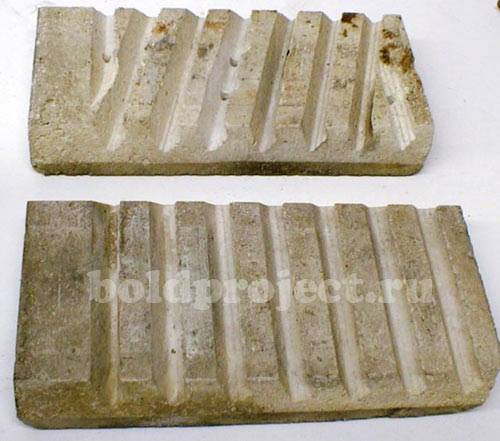
- Six or seven (optional) refractory brick blanks must be very carefully adjusted at the joints so that the muffle is obtained without gaps. Next, you need to press all the bricks together with chamfers and fix them in this position with a special tie. It can be made of a metal tape 2-3 cm wide. At the ends of the tie, it is necessary to provide devices that tighten the tape. After assembly, you get a six or seven-sided muffle design.
- Then, it is necessary to make several cross cuts in each refractory brick of the blanks. A heating element in the form of a spiral will fit into them. The grooves are made with an abrasive saw. In one workpiece, the grooves are made with an inclination, and in the rest they are horizontal. The distance between the grooves is at least 2 cm, and the configuration must match the diameter of the electric spiral placed in them.

Assembling and pouring the frame
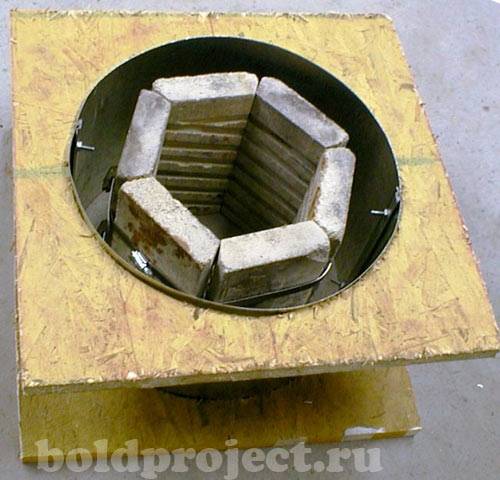
Having assembled the muffle into one piece, you can start making the frame (casing). To do this, you need to select a metal pipe of the required diameter. In this case, there must be a gap of at least 150 mm between the bricks and the frame, for better insulation and reducing heat loss of the electric furnace. In the absence of a finished pipe, the casing can be made independently from galvanized sheet steel.
The assembly of the muffle and the furnace casing must be carried out in the following order:
- Place the refractory structure on a level surface.
- Cut holes in two boards made of planks, thick plywood or chipboard, corresponding to the diameter of the furnace casing.
- Insert the lower part of the casing into one shield, and the upper end of the pipe into the second.
- Shields need to be fastened so that they do not slide over the smooth metal surface. This will prevent deformation of the sheet metal and accidental movement from place during further work.
- Then, a solution of heat-resistant and heat-insulating material is carefully poured into the space between the muffle brick and the casing.

Oven assembly and inspection
The assembly begins with the fabrication of the muffle furnace bottom, which can be made as a separate structure. This will make it easier to carry the oven piece by piece to the place of use.
-
-
A cylinder with a diameter equal to the dimensions of the casing and a height of 25-30 cm is made of galvanized sheet. Legs made of a pipe or profile metal with a cross section of 2 cm are attached to it, to exclude fire hazardous situations.
-
At the bottom end of the workpiece, you need to make holes and weave a wire mesh through them. It will be the retaining element for the poured and cured refractory mortar. The lid of the muffle furnace is made in the same way, in which it is necessary to provide a technological opening for ventilation.
-
In the grooves of the muffle, lay a spiral of the required diameter, length and cross-section of the wire, so that the turns do not touch. Lead out the ends of the wire through ceramic tubes. It remains to bring the electrical wires and test the resulting design.
-
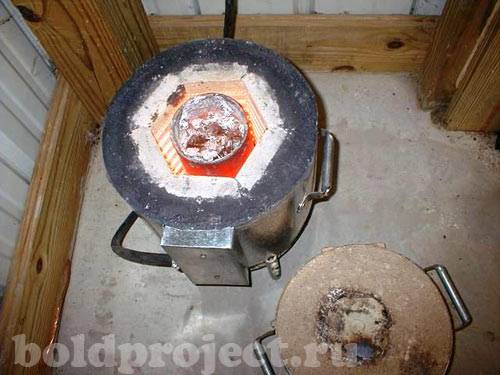
That's all for us, we'll meet in the next lesson.
Necessary materials
Materials will be needed directly for the manufacture of the furnace:
- fireclay brick
- one and a half kW spiral
- heat resistant clay or mortar
After its manufacture, it is placed in a casing. It can be welded from 2 or 3 mm steel sheets. Its dimensions are taken based on the dimensions of the oven. Also, in the form of a casing, you can use an old gas or electric oven, having previously removed all plastic parts and elements from it. The space between the oven and the casing is filled with an insulating material such as rock wool.
Top-loading kilns are best suited for firing ceramics. In furnaces where mainly work will be carried out with melting, quenching or other processing of metals, the process of heating the product should be controlled by using a temperature sensor, the workpieces are loaded into such chambers horizontally.
Let's consider step by step an example of a muffle furnace
In this case, an old iron rectangular tank is used for the casing. It should be slightly improved and it will be fully suitable for its role. Cutting off the edge of the tank with a grinder, on which there is a round hole, 5-10 cm wide. Drill holes along the edges for fastening the door to the body on the curtains.
The work should start with planning: Assemble a brick oven dry, make markings on it from the inside, in those places where you will need to lay a spiral. In the brick, according to the markings made earlier, with the help of a drill, using a victorious drill, recesses should be made. In the illustration below, the drill is set at an angle to the groove, this is how you can optimally achieve the desired result.
We put the prepared brick into the oven; an external frame for it should be made from the corner. We put a spiral into the grooves. We coat the entire structure with a mortar solution on water. All cracks should be covered.
Next, you should make an electronic unit that will control the heating of the spiral. Moreover, it will not be easy to heat up the oven, but it will be a stepwise heating. For this, a step thermostat is used. A support should be made under the muffle furnace in order to avoid losses at the bottom. The frame from the corner is cut and welded at the corners, on the sides the legs are welded onto it, also from the corners. A row of plates are welded on top.
We use a special fiberglass heat shrinkage. It serves to protect a thermocouple, the characteristics of which are as follows: chromel-alumel (TXA) diameter 0.5 mm, length 1 m. We also use a ceramic tube with two thermocouple holes. You will need another thick heat shrink to power the spiral.We put on a heat-resistant fiberglass cambric on the thermocouple, insert its tip into a ceramic tube. At the top of the stove, a hole is made with an ordinary drill and a thermocouple must be inserted there and covered with mortar. Allow to dry.
To connect, you need a special heat-resistant wire for electric ovens. The coated stove is hidden in a casing, its thermal insulation will be provided by basalt wool. At the top of the casing, you need to make a hole for the output of the power wires and the thermocouple to control it. Before the final packing in cotton wool, a test connection of the oven should be made.
The device itself is mounted on an asbestos sheet. The cotton wool should be laid with medical gloves. Control unit for the oven. Next, we proceed to the manufacture of the furnace control unit.
The set of accessories consists of:
- housing (taken from a small electrical room)
- electromagnetic contactee (in this case, still "Soviet")
- terminal blocks (one ceramic for connecting the nichrome spiral from the muffle furnace to the power wires, and more made of fire-resistant plastic for the main switching)
- machine for 16A; bolts, nuts, engraver; thick wire and plug
- thermostat Profile-M-1K multistage single-channel
The thermostat can heat up according to a complex schedule; you can set the heating time and temperature during this interval.
This is what the finished device looks like:
Heating the muffle with gas
A homemade muffle furnace can work not only from electricity, but also under the influence of a gas burner. Such a heating element can be purchased or made yourself.
To create a gas burner, a metal pipe 10-15 centimeters long is required. The pipe diameter should not exceed a few centimeters. First, a through hole should be made near the edge for supplying the gas pipe. Also, it is necessary to make several one-sided holes perpendicular to it. They are required to ignite the device.
For a gas burner, you need a metal pipe 10-15 centimeters long
The gas tube is made of copper, its diameter does not exceed 0.8 centimeters. Threads are required at both ends of the tube. In the middle of the device, you need to make a small blind hole for the gas to escape. One hole must be closed with a plug, and a gas cylinder must be brought to the other. When combining the elements of the device, be sure to install a valve between the hose and the burner, as it will protect the structure from fire.
